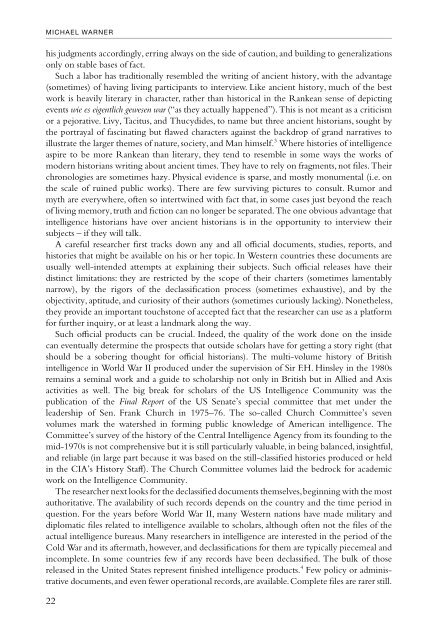Handbook of intelligence studies / edited by
Handbook of intelligence studies / edited by
Handbook of intelligence studies / edited by
Create successful ePaper yourself
Turn your PDF publications into a flip-book with our unique Google optimized e-Paper software.
MICHAEL WARNER<br />
his judgments accordingly, erring always on the side <strong>of</strong> caution, and building to generalizations<br />
only on stable bases <strong>of</strong> fact.<br />
Such a labor has traditionally resembled the writing <strong>of</strong> ancient history, with the advantage<br />
(sometimes) <strong>of</strong> having living participants to interview. Like ancient history, much <strong>of</strong> the best<br />
work is heavily literary in character, rather than historical in the Rankean sense <strong>of</strong> depicting<br />
events wie es eigentlich gewesen war (“as they actually happened”). This is not meant as a criticism<br />
or a pejorative. Livy, Tacitus, and Thucydides, to name but three ancient historians, sought <strong>by</strong><br />
the portrayal <strong>of</strong> fascinating but flawed characters against the backdrop <strong>of</strong> grand narratives to<br />
illustrate the larger themes <strong>of</strong> nature, society, and Man himself. 3 Where histories <strong>of</strong> <strong>intelligence</strong><br />
aspire to be more Rankean than literary, they tend to resemble in some ways the works <strong>of</strong><br />
modern historians writing about ancient times. They have to rely on fragments, not files. Their<br />
chronologies are sometimes hazy. Physical evidence is sparse, and mostly monumental (i.e. on<br />
the scale <strong>of</strong> ruined public works). There are few surviving pictures to consult. Rumor and<br />
myth are everywhere, <strong>of</strong>ten so intertwined with fact that, in some cases just beyond the reach<br />
<strong>of</strong> living memory, truth and fiction can no longer be separated. The one obvious advantage that<br />
<strong>intelligence</strong> historians have over ancient historians is in the opportunity to interview their<br />
subjects – if they will talk.<br />
A careful researcher first tracks down any and all <strong>of</strong>ficial documents, <strong>studies</strong>, reports, and<br />
histories that might be available on his or her topic. In Western countries these documents are<br />
usually well-intended attempts at explaining their subjects. Such <strong>of</strong>ficial releases have their<br />
distinct limitations: they are restricted <strong>by</strong> the scope <strong>of</strong> their charters (sometimes lamentably<br />
narrow), <strong>by</strong> the rigors <strong>of</strong> the declassification process (sometimes exhaustive), and <strong>by</strong> the<br />
objectivity, aptitude, and curiosity <strong>of</strong> their authors (sometimes curiously lacking). Nonetheless,<br />
they provide an important touchstone <strong>of</strong> accepted fact that the researcher can use as a platform<br />
for further inquiry, or at least a landmark along the way.<br />
Such <strong>of</strong>ficial products can be crucial. Indeed, the quality <strong>of</strong> the work done on the inside<br />
can eventually determine the prospects that outside scholars have for getting a story right (that<br />
should be a sobering thought for <strong>of</strong>ficial historians). The multi-volume history <strong>of</strong> British<br />
<strong>intelligence</strong> in World War II produced under the supervision <strong>of</strong> Sir F.H. Hinsley in the 1980s<br />
remains a seminal work and a guide to scholarship not only in British but in Allied and Axis<br />
activities as well. The big break for scholars <strong>of</strong> the US Intelligence Community was the<br />
publication <strong>of</strong> the Final Report <strong>of</strong> the US Senate’s special committee that met under the<br />
leadership <strong>of</strong> Sen. Frank Church in 1975–76. The so-called Church Committee’s seven<br />
volumes mark the watershed in forming public knowledge <strong>of</strong> American <strong>intelligence</strong>. The<br />
Committee’s survey <strong>of</strong> the history <strong>of</strong> the Central Intelligence Agency from its founding to the<br />
mid-1970s is not comprehensive but it is still particularly valuable, in being balanced, insightful,<br />
and reliable (in large part because it was based on the still-classified histories produced or held<br />
in the CIA’s History Staff). The Church Committee volumes laid the bedrock for academic<br />
work on the Intelligence Community.<br />
The researcher next looks for the declassified documents themselves, beginning with the most<br />
authoritative. The availability <strong>of</strong> such records depends on the country and the time period in<br />
question. For the years before World War II, many Western nations have made military and<br />
diplomatic files related to <strong>intelligence</strong> available to scholars, although <strong>of</strong>ten not the files <strong>of</strong> the<br />
actual <strong>intelligence</strong> bureaus. Many researchers in <strong>intelligence</strong> are interested in the period <strong>of</strong> the<br />
Cold War and its aftermath, however, and declassifications for them are typically piecemeal and<br />
incomplete. In some countries few if any records have been declassified. The bulk <strong>of</strong> those<br />
released in the United States represent finished <strong>intelligence</strong> products. 4 Few policy or administrative<br />
documents, and even fewer operational records, are available. Complete files are rarer still.<br />
22
















